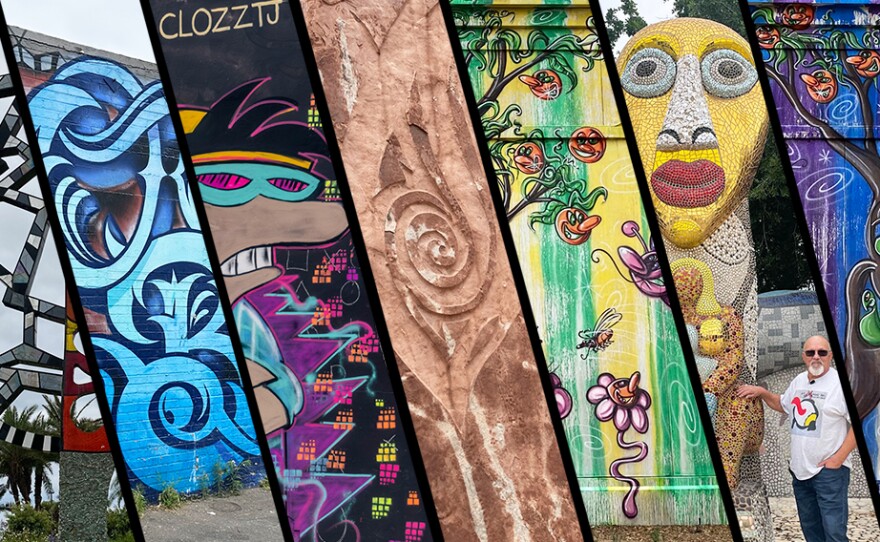Note: This story is part of an ongoing series about public art in the San Diego region.
Artist Roberto Salas slapped the ancient sandstone pillar that makes up one of his most iconic works in San Diego, "Plaza Piedras."
“This is art you can actually touch,” Salas said.
The imposing 67-year-old has the distinction of being one of San Diego’s first public artists.
He's been prolific over the years, producing memorable public art across the region from La Jolla to Mira Costa College. His work can also be found in Los Angeles and Manhattan Beach.
Among his more notable installations include the 12 flashy Park Boulevard sculptures called “Night Visions” created to make the city more alluring ahead of the 1988 Super Bowl.
Dressed in cowboy-style clothing complete with a Stetson hat, Salas strolled through one of his most treasured works, "Plaza Piedras," on a recent May morning. He reminisced about how he conceived the project he created in 2001 on Grove Avenue in the South Bay community of Nestor.

San Diego’s Commission for Arts and Culture hired Salas to design "Plaza Piedras" to offset the drab, industrial feel of the adjacent wastewater treatment facility called the Grove Avenue Pump Station. The installation sits in what was once an empty lot, surrounded by homes and apartments. He drew his inspiration for the artwork from the local community and his own background.
“There were a lot of people walking though this particular street, in this community of Nestor, with strollers, and a lot of families,” Salas said. “I said I have to create something that sort of offers the families a place to be, a place to walk, to meditate, to think.”
It starts with a few sandstone benches that line Grove Avenue, then continues on either side of a sidewalk into the park all the way to its center. There stand four 13-feet tall sandstone pillars representing earth, water, fire and wind.
“I needed something upright, by upright I mean something to look up at and admire,” Salas said. “It’s bigger than we are. Everybody says, 'Oh, is it Stonehenge?'”
He answers no.

But the pillars and benches are no less primordial than Stonehenge. They’re made of terra cotta-colored sandstone that was extracted, cut and transported from the quarries of Salas’ native New Mexico. He said he asked permission from the ancestors to remove the stone.
He believes he received his answer through a pleasant breeze, a voice in his mind saying yes. Salas offered gratitude for the stone by burying tiny bundles of corn kernels and sage underneath as an ode to his forefathers.
“I’m a continuing link from that culture that is bringing something forth to our community at this point,” Salas said. “I like the relationship. I think it’s very important.”
The stone pillars are interspersed with benches. They encircle a round sand area, where if you dig, you can find concrete sketches of the area’s history, a dinosaur, a dairy farm, even drip irrigation.
“So the kids can come in here and start digging,” Salas said. “It creates some curiosity, a little bit of critical thinking to ask, 'What’s this all about?'"
Salas believes "Plaza Piedras" epitomizes the best of public art. It should reflect the history of a community, educate, motivate contemplation and be accessible. It should be democratic.
Salas’s own entry into public art was prompted by a failure to break into the mainstream art world, he described as dominated by a well-entrenched hierarchy uninterested in showcasing work by people of color. He said galleries rejected his work numerous times because they were fixated on art produced by “anglos.”
“There were a lot of people walking though this particular street, in this community of Nestor, with strollers, and a lot of families. I said I have to create something that sort of offers the families a place to be, a place to walk, to meditate, to think.”Roberto Salas, artist of "Plaza Piedras"
He turned to mural painting. He liked that it carried social justice messages from César Chávez’s demand for workers’ rights to Martin Luther King’s dream of racial equality. At the same time, he said his projects paid him well. Some years, he has made six figures.
“People say, 'Gosh, you’ve been very successful' and I say, 'Yeah, you haven’t seen all the rejections.' I just keep plugging away. When I don’t apply to something, I feel like I haven’t gotten up in the morning to go to work,” Salas said.
These days, Salas is working on a piece for the Port of San Diego. He conjured up the idea for a giant aluminum wishbone by following his usual process when asked to create a piece of art.
“I walked around the port,” Salas said. “I laid on the ground. I listened. I noticed all the traffic. I smelled the air. I looked at the sky. I saw the birds, their wings. I thought people have done wings before. Then I asked what is the most important part of the bird? The furcula. The furcula is the wishbone.”
He has the same hope for the port art project as he does for all of his other work.
“They’ll outlive me and that’s the beauty of public art,” Salas said.








